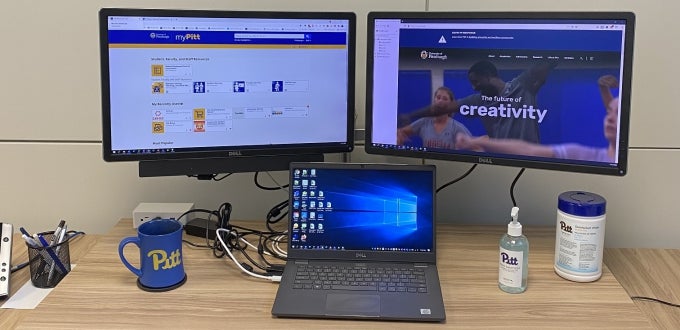You are here
Hybrid First: Implementing a Hoteling Office for the CFO

For the past 18 months, many campus offices have been empty. Hallways were quiet, office doors were locked, and lights stayed dark. But recently, the familiar hum of a new academic year grew louder, with thousands of students moving into the residence halls and in-person activities resuming.
But after a year of pandemic operations, departments had digitized various processes and many staff grew to appreciate the benefits of working remotely. So moving forward, a lot of offices will look a bit different as they accommodate flexible work schedules for staff who don’t need to be on campus every day.
Student Financial Services (SFS) jumped at the challenge, creating Pitt’s first dedicated hoteling workspace in Thackeray Hall in July. The Office of the CFO collaborated with Pitt Information Technology to equip various offices with the tools needed to run a successful hybrid work environment.
Defining a Hybrid Workspace
A hybrid workplace supports both remote and on-site employees at the same time, creating a virtual bridge between the two to support a flexible and productive environment for all. “We want to make sure that everyone coming into a hybrid workspace has a consistent experience,” says Julie Cursi, departmental relationship manager for Pitt IT who was the lead project manager. “Our goal is to make a seamless and enjoyable transition between remote and in-person work.”
Each SFS employee now has their own Pitt-issued laptop, instead of using an office desktop or a personal computer. If an employee wants to work from home, they simply work on their laptop in their home office. When they come to campus, they reserve a space through Pitt IT’s in-house online reservation system and then bring their laptop to work in an available cubicle. Each hoteling cubicle contains dual monitors, a keyboard, and a mouse. Staff just dock their laptop and work with a desktop-like setup, where they can access their local and remote network resources through PittNet Wi-Fi.
“Our plan is to provide a solution that reduces the clutter on the desks by getting rid of clunky desktop PCs, eliminating the tangle of wires, and reducing the amount of hardware accessories needed for things like audio, video, and printing,” says James Lee Tyler, a Pitt IT consultant who oversaw the hardware implementation.
The Journey to a New Normal
Cyndee Pelt, the CFO's chief of staff, explains that SFS’s redesigned space was months in the making. The initiative started with a staff survey in December to learn how employees felt about working remotely. Pelt saw that many people enjoyed telework and still felt engaged while working at home. The results suggested that once the University started to reopen, there was an opportunity to revise the CFO’s telework guidelines.
After the survey, supervisors were tasked with laying out a hybrid work plan that accommodates how often each staff member expects to be in the office and what they are looking for in a hybrid workplace. While some CFO staff plan to work in person full-time, the majority are choosing to come into the office once or twice a month. So Pitt IT and CFO project partners created extensive floor plans of various spaces in order to determine how to best utilize and consolidate space.
Adjusting to the Space
SFS was chosen as the first CFO hybrid workspace because they are a more student-facing office. Corey Jackson, SFS director of operations, said his team came into the office more frequently in the last year to collect mail and perform other tasks that could not be translated into a virtual setting. The majority of the SFS team will be coming into the office two days a week or more.
Jackson is excited about the new hybrid space and being able to see and work with people in person again, but acknowledges that there were a few bumps in the road when transitioning to the hybrid model. “It’s definitely been an adjustment for our team. The flexibility has been great, but we’re still figuring out the best way to keep everyone on the same page when some are working in the office and others are at home. As a manager, there can be challenges,” he explains.
However, Jackson’s team is happy with the technology and the support that Pitt IT provided throughout the process. “The equipment all works great. The tech transition was actually much smoother than I thought it would be. This was going to be a significant change in technology for staff, so I had some initial concerns,” Jackson says.
According to Tyler, Pitt IT set up each SFS staff member’s new laptop and extensively trained SFS staff on how to use the new hardware in the office. “It was a game changer to see the user experience once they connected their laptop to the hybrid workspace for the first time,” he notes.
A Model to Build On
The SFS hybrid set-up is the first of many hybrid workspaces within the CFO’s office. According to Pelt, more hybrid workspaces will be popping up across campus this semester and beyond, including in the Cathedral of Learning, Craig Hall, and more. “We feel that remote and hybrid work are both effective and productive options for our office. Our goal is to align with our strategic plan, as well as recruit and retain top talent, and we think embracing a hybrid work environment can accomplish that,” says Pelt.
Pitt IT is prepared to help other units implement their own hybrid workspaces. The Computing Equipment Purchasing and Standardization Program was expanded to include a range of compatible laptops, docking monitors, and other accessories to help departments quickly and affordably get the needed equipment. In addition, Pitt IT is investigating an enterprise solution for workspace reservations.
If your department is investigating a hybrid workspace, reach out to Pitt IT so they can share their experience and lessons learned for use in your area.
-- By Mary Rose O’Donnell, Student IT Blogger